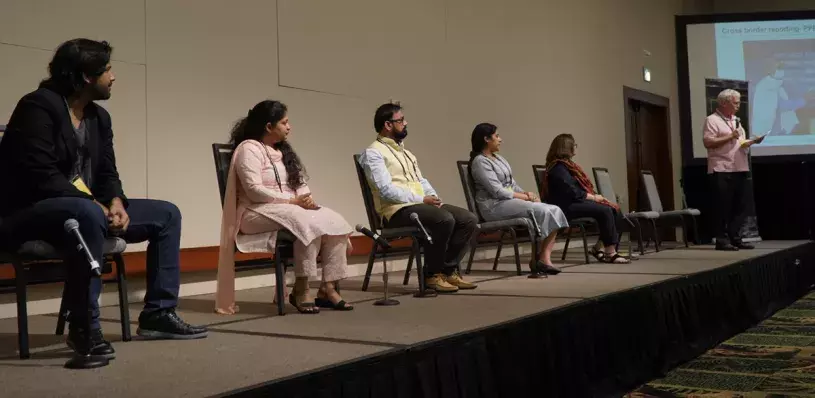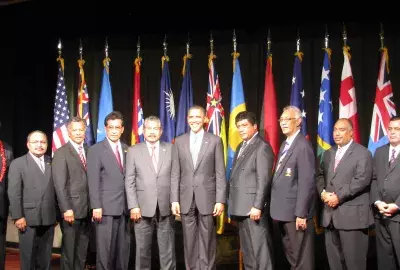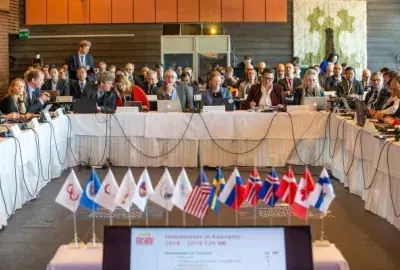Error message

OFFICE/DEPARTMENT
HONOLULU (June 30, 2022) — As unfriendly neighbors politically, India and Pakistan are rarely able to find common ground despite their extensive shared heritage. But a panel of Indian and Pakistani journalists who have participated in a cross-border peace journalism project between the two countries told several hundred media professionals gathered at the recent East-West Center International Media Conference that the experience taught them they had more in common than they ever realized.
Moderator and peace journalism advocate Steven Youngblood asked panelists at the session on “Connection Through Cross-Border Collaboration” whether the project had “changed the way you look at the other side.”
One Pakistani panelist, Lubna Jerar Naqvi with the International Federation of Journalists, commented that the collaboration gave her the insight that “Indians and Pakistanis, we are reflections of each other. A lot of issues that we're facing in Pakistan, the same issues were reflected in India.” Naqvi said she realized that “we can join forces and work for the issues in the region because we are neighbors. We have to live peacefully.”
Pratyush Ranjan, executive editor of Jagran New Media in New Delhi, commented: “We feel pain when we see people from both sides facing the same issue they were facing decades before.” Khuldune Shahid, Pakistan correspondent for The Diplomat, quipped that since he has close relatives in India, “I've always believed that we are two different nations, but one family. A nuclear-armed family, but a family nonetheless.”
Covering topics of common concern
Some 80 journalists have participated in the program titled “Reporting on Cross-Border Issues of Mutual Concern,” an ongoing project started by the East-West Center in 2016. Participants are grouped by four separate topics so they can cover more issues: economy/trade, water and environment, agriculture, and health. Stories they have produced tackle issues ranging from mental health and societal bias to culture and women's issues. View their work on their website: Journalists for Change.
Disha Shetty, a staff reporter for The Fuller Project from Pune, India, commented: “All developing countries are on one side, but if we are not talking to each other, we’re just doing a huge disservice to ourselves. Not talking to each other is a major flaw, and it gets in the way of finding global solutions.”
As a reporter based in the disputed area of Kashmir that is the biggest flashpoint of hostilities between India and Pakistan, independent multimedia journalist Safina Nabi said, “Observing both sides has really helped me to understand the political nuances that they each have, and the ideology or ideas behind what they think about Kashmir.”
The panelists said the cross-border program participants are working together to build a bridge by sharing their communities’ stories and solutions. They hope to create a space where journalism can become an ambassador for peace and shared facts.
—By Jordan Nunies, University of Hawaiʻi at Mānoa
HONOLULU (June 30, 2022) — As unfriendly neighbors politically, India and Pakistan are rarely able to find common ground despite their extensive shared heritage. But a panel of Indian and Pakistani journalists who have participated in a cross-border peace journalism project between the two countries told several hundred media professionals gathered at the recent East-West Center International Media Conference that the experience taught them they had more in common than they ever realized.
Moderator and peace journalism advocate Steven Youngblood asked panelists at the session on “Connection Through Cross-Border Collaboration” whether the project had “changed the way you look at the other side.”
One Pakistani panelist, Lubna Jerar Naqvi with the International Federation of Journalists, commented that the collaboration gave her the insight that “Indians and Pakistanis, we are reflections of each other. A lot of issues that we're facing in Pakistan, the same issues were reflected in India.” Naqvi said she realized that “we can join forces and work for the issues in the region because we are neighbors. We have to live peacefully.”
Pratyush Ranjan, executive editor of Jagran New Media in New Delhi, commented: “We feel pain when we see people from both sides facing the same issue they were facing decades before.” Khuldune Shahid, Pakistan correspondent for The Diplomat, quipped that since he has close relatives in India, “I've always believed that we are two different nations, but one family. A nuclear-armed family, but a family nonetheless.”
Covering topics of common concern
Some 80 journalists have participated in the program titled “Reporting on Cross-Border Issues of Mutual Concern,” an ongoing project started by the East-West Center in 2016. Participants are grouped by four separate topics so they can cover more issues: economy/trade, water and environment, agriculture, and health. Stories they have produced tackle issues ranging from mental health and societal bias to culture and women's issues. View their work on their website: Journalists for Change.
Disha Shetty, a staff reporter for The Fuller Project from Pune, India, commented: “All developing countries are on one side, but if we are not talking to each other, we’re just doing a huge disservice to ourselves. Not talking to each other is a major flaw, and it gets in the way of finding global solutions.”
As a reporter based in the disputed area of Kashmir that is the biggest flashpoint of hostilities between India and Pakistan, independent multimedia journalist Safina Nabi said, “Observing both sides has really helped me to understand the political nuances that they each have, and the ideology or ideas behind what they think about Kashmir.”
The panelists said the cross-border program participants are working together to build a bridge by sharing their communities’ stories and solutions. They hope to create a space where journalism can become an ambassador for peace and shared facts.
—By Jordan Nunies, University of Hawaiʻi at Mānoa
Web Article
Recent online articles and analysis that have been published on the East-West Center website.







